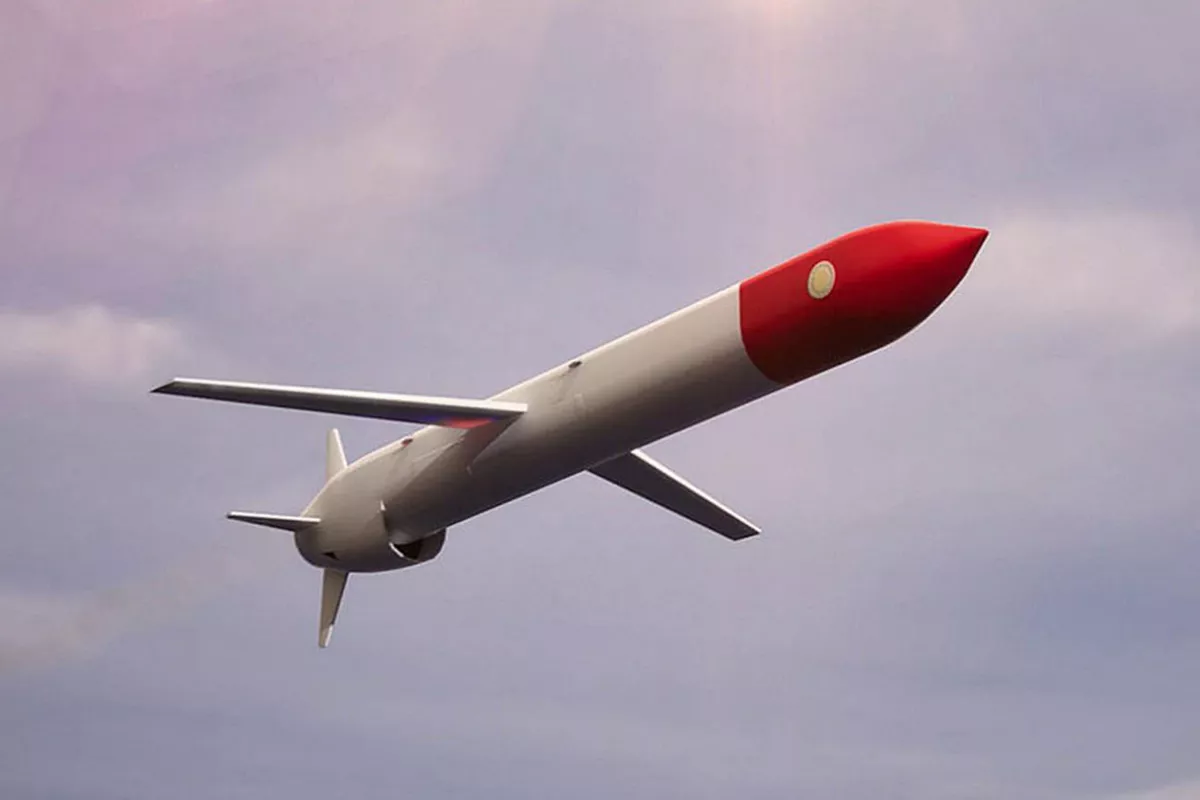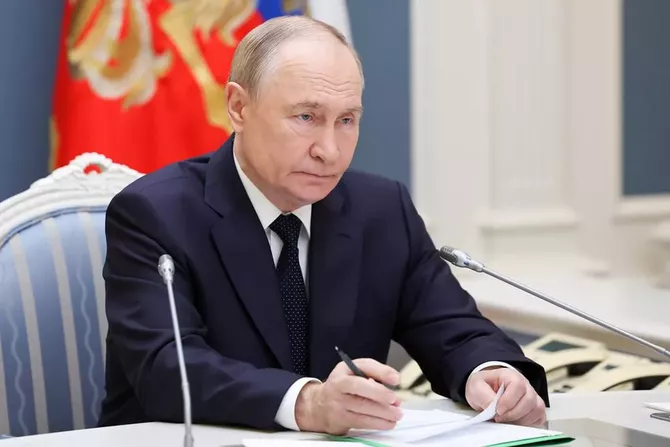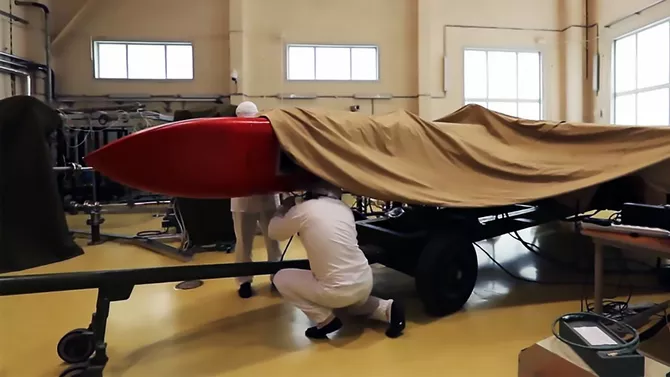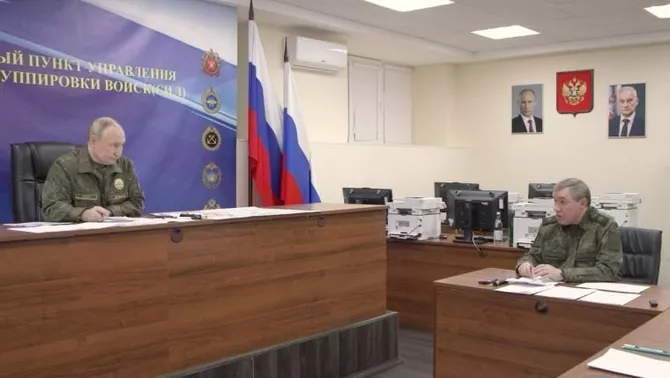
Photo credit: 1tv.ru
On October 26, Russian President Vladimir Putin, wearing camouflage, announced what he described as another achievement for Russia and the Russian people in their march toward development and progress.
Mr. Putin said Russian scientists and engineers had created a device unlike any other in the world and that it had passed successful tests. That device, he said, is the combat cruise missile with a nuclear power plant known as the Burevestnik. According to him, its uniqueness lies in an effectively unlimited range and the ability to reach any point on Earth.
Putin’s message was clear: the world, and any country that acts against or defies Russia, should understand that Moscow has acquired a new and powerful weapon with which it can strike disobedient states.
But a closer reading of media reports raises many questions, unclear details and even contradictions.

Photo credit: TASS
A key element of this system is its nuclear power plant. It is the reactor inside the missile’s engine that enables it to fly for long durations and across great distances.
We could go into the technical details of the system, but a brief overview will suffice. A fast-neutron reactor heats the air passing through the engine. That heated air is then accelerated to high speed and expelled through a nozzle, generating jet thrust that propels the missile forward. The reactor itself is compact, and sodium serves as the coolant circulating in the primary loop. It is this sodium, not the uranium fuel rods, that heats the air. In theory, this design prevents the surrounding air from being irradiated or contaminated. In other words, the missile should not leave behind any radioactive trace as it flies.
This is precisely what military officials proudly reported to President Putin at the meeting where the missile’s test results were discussed. They stated that the missile covered a distance of 14,000 kilometers over a span of 15 hours, and that foreign monitoring systems detected no signs of radiation during the flight. Here, however, a small question arises. I do not know exactly where the missile flew, but I doubt it travelled over the Atlantic or Pacific Oceans, or over Africa. It most likely flew over Russian territory. And since Russia’s landmass is not 14,000 kilometers across, the missile must have been manoeuvring, flying in circles or zigzags.
This assumption is supported by official reports of the test, which emphasised that the missile can evade missile defense systems by approaching a target from any direction and following an unpredictable trajectory.
Yet, if the missile was indeed tested over Russian territory, what “foreign monitoring systems” could have been used to assess radiation levels? That leaves the question of its radiological safety still open.
Another key question is that Russia’s political and military leadership so far appear unsure how to employ this missile. That conclusion follows from what President Putin told his Chief of the General Staff, Valery Gerasimov: “…We will need, Valery Vasilyevich, to determine what it is, to what class of weapons this new system belongs. We need to determine possible methods of employment and begin preparing the infrastructure to deploy this weapon in our Armed Forces.”
This instruction from Putin is revealing about the situation. Here’s the point: the Burevestnik missile reportedly has an average speed of about 850 kilometers per hour. By contrast, an intercontinental ballistic missile travels roughly 22,000 kilometers per hour outside the atmosphere, and 5,000-6,000 kilometers per hour within it. That means intercepting a missile moving at such a comparatively modest speed is, in principle, a solvable problem.

Courtesy of Russian Ministry of Defense
To defeat air and missile defense systems, therefore, the Burevestnik would have to fly very low - roughly 100 meters - following the terrain. That requires advanced electronics, precise navigation, and an excellent flight control system. So the challenge is far from trivial, especially given flights that last many hours.
One of the missile’s main claimed advantages is its ability to maneuver during flight and to approach a target from any direction. That matters because U.S. missile defense systems are calibrated to expect ICBMs from northern and northeastern azimuths; the Burevestnik could, in theory, approach from the south, the west, or any other vector.
There is historical precedent in the history of the arms race between the USSR and the U.S. During the 1960s, U.S. defenses were oriented toward intercepting Soviet missiles arriving from northern directions - the ballistic trajectories then determined likely approaches. At the time, Soviet leader Nikita Khrushchev boasted that the USSR had found a way to defeat American missile defenses, quipping: “They expect us at the door, but we’ll come in through the window!”
Khrushchev was referring to the Soviet 8K69 strategic orbital missile, developed to be launched not over the North Pole but to the south. The missile would follow a suborbital path, circle nearly once around the Earth, and approach the United States from a direction where American radars were not looking.
Today, deploying radar detection and tracking systems in all required directions on U.S. territory, and with partners abroad, is largely a matter of resources and finance. A relatively slow but course-changing cruise missile therefore remains, in many respects, a trackable target.
And now a further crucial question concerns the Burevestnik’s warhead and the doctrine for its use.
The Burevestnik is reported to be capable of carrying either a conventional or a nuclear warhead. If it did carry a nuclear warhead, it would be intended for use in a nuclear conflict, but how would that play out?
Suppose war breaks out and missiles from Russia and the United States strike one another, or Russia and Britain exchange strikes. At the same time, Russia launches missiles that would take 10-20 hours to arrive over the U.S. or Britain, while submarine-launched and tactical missiles reach their targets in minutes.

Photo credit: TASS
Or is Russia preparing in advance to start a nuclear war by launching nuclear-armed Burevestniks that, 15-20 hours after the decision to go to war, would arrive unexpectedly over an enemy and inflict a surprise strike?
Another important question is how such missiles would be counted and regulated (if at all) under international arms control treaties that limit strategic and nuclear weapons.
Now consider the Burevestnik armed with a conventional rather than a nuclear warhead. As I understand it, using such a missile against the U.S., France, or Britain would be unthinkable, because the risk of a nuclear response from those states would be very high. In other words, a conventional strike could itself trigger nuclear war, making Russia the “provoker” if it struck enemy territory with a weapon that is hard to intercept.
And if Russia intends to use the Burevestnik not against nuclear powers but against, say, Poland, the Baltic states, or Canada, then why deploy a missile with a range of nearly 50,000 kilometers when the target is at most about 1,000 kilometers away? Why launch a missile that must circle over Russia, Belarus, and the Arctic for many hours and only then approach Poland from the direction of Finland, supposedly undetected during those 10 hours?
I don't understand.
Share on social media